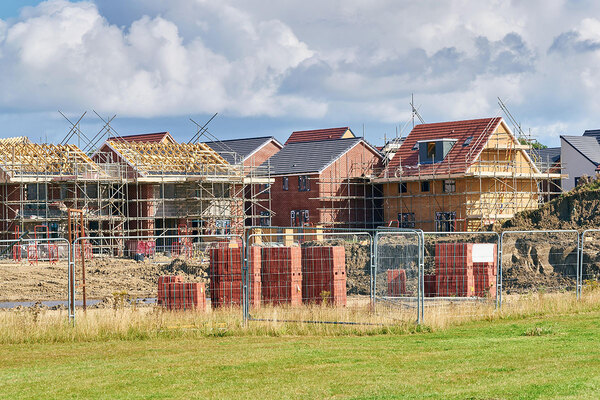How a proposed new model would use guarantees to reprofile debt costs and make grant go further
Proposals to use government guarantees to make grant go further through a new ‘Affordable Housing Acquisition Scheme’ have been set out in a research paper from impact advisory Social Finance. Social Housing looks into how it would work

A new report has proposed a financing model intended to make grant go further towards the development of new homes, by using a government guarantee to reprofile debt servicing costs over the long term.
By weighting repayments towards the end of the proposed 30-year tenor of the scheme, the model aims to better match the rental income of the homes whose development it funds. This, the authors propose, would mean that less grant is required to make the initial development cost of the homes viable.
Written by non-profit impact advisory Social Finance, in association with the Joseph Rowntree Foundation, the report proposes a model it calls the ‘Affordable Homes Acquisition Scheme’ (AHAS).
This would see guaranteed debt issued via a bond or loan agreement by an independent entity – or ‘Asset Co’ – that owns the new or in-development homes. Registered providers would manage the homes and would also act as shareholders in ‘Asset Co’.
The report, Affordable Homes Acquisition Scheme: A briefing paper, estimates that, relative to the Affordable Homes Programme (AHP), the level of capital grant required from the government could be decreased by up to 35 percentage points.
This modelling focuses on the delivery of homes at affordable rent specifically, for which it believes 20 per cent of grant would be required per home, compared with upwards of 50 per cent in the AHP.
Proposing a £500m pilot scheme that would acquire around 2,500 to 3,000 homes, the authors believe that this could scale to a £2bn annual scheme and boost current delivery figures for affordable rent by 25 per cent.
It also notes that the model could be flexible to other rented tenures, with social rent requiring more capital grant per home but still a lower proportion relative to other schemes.
Social Finance proposes that homes acquired into the scheme would be forward purchases from the existing development pipelines of housing associations, but suggests that purchases could also target other new build homes or existing stock.
In response to the financial constraints on housing associations, and citing the fact that in 2024 the cost of servicing debt for private registered providers exceeded net earnings for the first time in 15 years, the model is designed to sit off-balance-sheet.
However, while AHAS would raise 70 per cent of debt, the remaining 30 per cent is expected to be provided “in the form of equity largely from participating housing associations and potentially partially funded by capital grants”.
Modelling in the report assumes that this would comprise 10 per cent equity and 20 per cent grant.
The publication also states that “initial feedback is that Asset Co would not be required to be a registered provider”.
‘Step up’ structure
Repayments over the bond or loan term would have a ‘step up’ structure, meaning that these are higher towards the end of the proposed 30-year term and that the terminal payment is much higher than for a conventional bond.
As an example, the report compares an illustrative step-up bond with a conventional bond. Both concern a principal amount of £100m over a 30-year term, and deliver an investor annualised return, or internal rate of return, of six per cent.
The conventional bond might see debt servicing costs of six per cent in each year and a final repayment of the £100m principal. By contrast, the step-up structure would see lower initial debt re-servicing costs of 1.75 per cent per year, increasing by 0.5 per cent every five years, and would culminate in a terminal payment of £365m.
Taking the net rent assumptions of the properties delivered over the period, the report’s modelling suggests that the AHAS is able to generate a cash surplus from inception using just 20 per cent of grant, whereas a conventional bond is not.
Risk to guarantor
However, the debt-to-assets ratio would be much higher at the bond term (70 per cent), compared with homes delivered through the Affordable Homes Programme (10 per cent), albeit while using a smaller proportion of grant (20 per cent vs 50 per cent). The report therefore notes that the AHAS would be “much more exposed to residual asset values than a typical AHP model”.
This would also mean exposing the government as guarantor to “much greater risk” than its current guarantee scheme – the Affordable Homes Guarantee Scheme – where loans are backed by registered provider covenants with additional security from charged assets.
The report also acknowledges a need to determine how much of the scheme obligation would be classified as on the government’s balance sheet for its own accounting purposes, with regard to public sector net financial liabilities. But it believes that the government guarantee underpinning the bonds issued would “remain a contingent liability with only a small portion of the guaranteed debt value falling on the government balance sheet based, as is likely, on a default risk assessment.”
Developing the model
Speaking to Social Housing, Jonathan Flory, co-author of the report and a senior advisor at Social Finance, said the consultancy had been through “several chapters” of the project to develop this model, starting with work with the government and a group of housing and investment stakeholders to consider “how guarantees can work a bit harder in the system”. More recent work has been to refresh that earlier research, with support from the Joseph Rowntree Foundation.
Early iterations of the model involved looking at index-linked financing, Will Damazer, report co-author and associate director at Social Finance, says. However, at current interest rates and pricing, index-linked funding looks less attractive and so the step-up bond has been proposed to provide some of the benefits while not adding to the stock of index-linked securities, Mr Damazer adds.
Asked whether housing associations might find it challenging to free up equity capital of their own to invest in the scheme, Mr Flory refers to a “useful precedent” in the form of the Welsh Housing Partnership, set up in 2011 and involving four registered social landlords. The initiative has seen the housing associations invest equity, including capital grant from the Welsh government, into a joint venture alongside private debt finance to develop homes. These are then leased back to the housing associations to let to tenants at sub-market rents.
Mr Flory adds: “So part of the answer is there, which is that you could set up a structure where the housing associations have some skin in the game and they have to put a bit of the equity in themselves, but potentially a large part of the equity could come from reprocessing capital grant, so I think the model is flexible.”
Social Housing also asked about the house price inflation elements baked into the model and whether there is an expectation that homes would need to be sold at market value at the end of the scheme.
The report refers to an assumption that the AHAS would rely on “house price growth and refinancing or, if needed, portfolio sales to pay down the scheme debt raised.”
It notes: “In our central scenario, house price growth is required to be c.2.9% per annum. Historically the minimum annualised house price growth over a 30-year period is 5.9%. Accordingly, we believe that the AHAS structure offers [the government] as guarantor an acceptable risk of low default and meanwhile offers a much more efficient use of capital grant.”
Mr Damazer tells Social Housing: “Regardless of whether it comes in as EUV-SH or market value, the assumption is essentially that how it exits is how it comes in. So we might be able to get a discount on schemes as we purchase, and invested homes will grow at that inflation rate over the period of the scheme. Or if we buy at market [value], we can value it at market at the end of the scheme,” Mr Damazer says.
He adds: “Over a 30-year period there could be scope to convert a portion of the homes if needed to market at the end of tenancies. This is one area where further detailed work is required.”
Mr Flory and Mr Damazer are both keen to emphasise that they see the proposed model as providing a part of the funding mix that could be available to the sector, to free up capacity to develop, rather than a replacement for grant or existing guarantee schemes.
The £500m pilot proposed (or £2bn scaled-up model) represents the entire value of the scheme, of which 70 per cent is the guaranteed debt. This could fund around 2,500 to 3,000 homes, the authors believe.
Next steps for the research project would include establishing a “cross-governmental working group” and engaging stakeholders to identify and address practical challenges, the paper sets out.
Sector viewpoints
Social Housing approached finance and funding stakeholders in the sector for their views on the proposals.
Tom Paul, executive director of strategy and change at Southern Housing, told Social Housing that the report’s “diagnosis of the current central challenge to housing association investment capacity is correct – interest cover”, and that the proposed solution goes “directly to alleviating” this. He welcomed the proposal for a structure that would use government guarantees to support a rising coupon to enable associations to “pay less interest now, pay more in the future when the assets are generating more income”.
But he posited that such a scheme might have more impact on the balance sheets of associations without the need for an off-balance-sheet ‘Asset Co’ to own the homes, as this would be less complex and costly to implement, and the scheme would rely on provision of low-cost equity from associations regardless.
He also acknowledged that one of the risks to be navigated within the step-up financing would be “having to make lots more projections about the future to get comfortable with your ability to pay the higher interest rate”.
However he highlighted that there was already precedent for structures involving incrementally increasing interest rates – on bank facilities, for example. In addition, some associations have previously sold bonds at a discount to the principal amount (for example where the coupon on older or retained bonds is lower than the interest rates in today’s market), so that the cash flow for investors is weighted towards a higher repayment at the end of the bond term.
“[The important part of the story] is if there are ways of deferring interest costs so that interest cover capacity can be freed up to make investments”, Mr Paul said.
And he emphasised that multiple options needed to be on the table in government to help make social housing investment more viable and improve sector capacity. “There is a real urgency here,” he said.
Priya Nair, chief executive of funding company and sector bond aggregator The Housing Finance Corporation, said: “It’s important that we keep the discussion going around how we diversify and expand the range of financial solutions available to the social and affordable housing sector.
“THFC would welcome the prospect of UK government extending the use of guarantees. While the programme shouldn’t be seen as a replacement for capital subsidy, it is an important tool to help support housing associations address some of the most pressing challenges and attract much-needed investment in existing and new homes.
“We see partnership and collaboration as essential in the current environment.”
Social Housing is interested in hearing about other proposed solutions to meet the sector’s challenges. Please contact Sarah Williams and Michael Lloyd if you have upcoming news, research or ideas to share.
And join your peers at the Social Housing Finance Conference on 14 May in London to take part in the discussion and learn how sector leaders are tackling current pressures with new models and partnerships.
Sign up for Social Housing’s weekly news bulletin
Social Housing’s weekly news bulletin delivers the latest news and insight across finance and funding, regulation and governance, policy and strategy, straight to your inbox. Meanwhile, news alerts bring you the biggest stories as they land.
Already have an account? Click here to manage your newsletters.
RELATED








